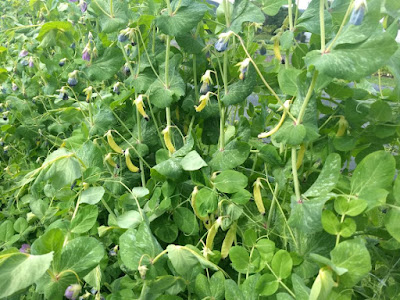One of the things I greatly enjoy about gardening is that it provides endless opportunities for learning. Though the gardener may grow a variety of vegetable in the garden one year, changing a couple factors the following year can dramatically change the outcome of the crop. A particular issue that many gardeners experience is limited space in the garden bed to grow their crop. While some choose to remedy this problem by growing in containers, container growing can be especially challenging in areas with intense sunlight or heat. Unless the gardener has the resources to obtain a very large container or one that is somehow insulated from the worst aspects of the climate, direct sun hits the sides of the container and, when combined with heat, can damage roots or dry soil to the point at which the plants suffer, dither and their health in general deteriorates.
My experience with gardening in containers has been like this. Even in a very large wine barrel, the plants in the container do not live to their potential and if they produce, the fruit is smaller and the harvest is much less. So now I generally garden in containers only when I am experimenting with a variety that I just need some basic information about or I grow in containers with the intent to place the entire container into the ground. By using a 10” hydroponic basket I am able to solve the issue of “not enough space” by growing my plants in a container until a spot in the garden opens up for me to plant.
10 inch hydroponic baskets are definitely a mixed blessing. Here are some of the pros and cons of using them as a method of transplanting into a garden:
Pros:
-Fits perfectly into a 1-gallon container for ease in initial growing and transporting to the garden bed-Makes it possible for transplants of a very large size.
-Enables the gardener to maximize harvests of multiple summer crops in a small area.
-Fragile roots of the plant are not put in a state of “shock”.
-Roots grow through the basket and make use of the nutrients, moisture and biology already present in the soil.
-Dramatically increases the survival rate of plants because they are both larger when being transplanted and because the lip of the basket can be placed just above the soil line (as a barrier to creeping critters)
-Mitigates disease for the observant gardener by keeping disease contained to the soil in the basket. The gardener can remove the plant from the garden before disease spreads any further.
Cons:
-Damages soil by requiring the gardener to make a hole that is over 10 inches in depth and width.
-Dramatically increases labor required to plant the crop (labor is multiplied by 3 or 5 times what it normally would be in preparation of the soil, growing the plant and in transplanting of the basket)
-Dramatically increases labor required to remove the crop (labor is multiplied by 5-10 times what it normally would be in removing the basket, leveling the soil, in repurposing the soil and cleaning the basket)
In talking about transplanting large hydroponic baskets, I don’t want to paint too rosy a picture of the work involved. First one needs to get the baskets, then compact soil into the basket. If there is not enough compaction, the soil will fall through the cracks. Then the seeds or soil block is planted into the basket. It generally takes more time to water plants in 5-gallon buckets than in the ground. To transplant, the gardener needs to dig a hole that is over 10 inches in width and depth, then fill in the soil so that it is in complete contact with the bucket. Any trellising needs to work with a 10 inch plastic container. It requires much more time and energy than regular planting of seeds or soil blocks would.

At the end of the season, when the plants have been removed, the work required is even greater. The basket is carefully removed (now that the roots have grown through the container and established themselves in the garden, they need to be torn free to be able to remove the basket). Then the hole in the garden bed is filled, leveled and the soil in the basket is repurposed. Then the basket is cleaned, dried and stored for the next season.
On the flip side, the benefits are amazing. If the gardener has minimal space and planting time, the gardener can make a lot of use of the limited time they have to grow a whole lot. The old crop can be replaced by transplants that have grown for 4-6 weeks. If fruit is not already set on the plant, the plants are so large that fruit develops quickly. Transplanting 10-inch hydroponic baskets is not for everyone, but the ability to get multiple from seed to harvest in the time it would take to get one crop to maturity may be worth all the work involved.
Last, but not least, here is a video to demonstrate a little about how this is done:





















































